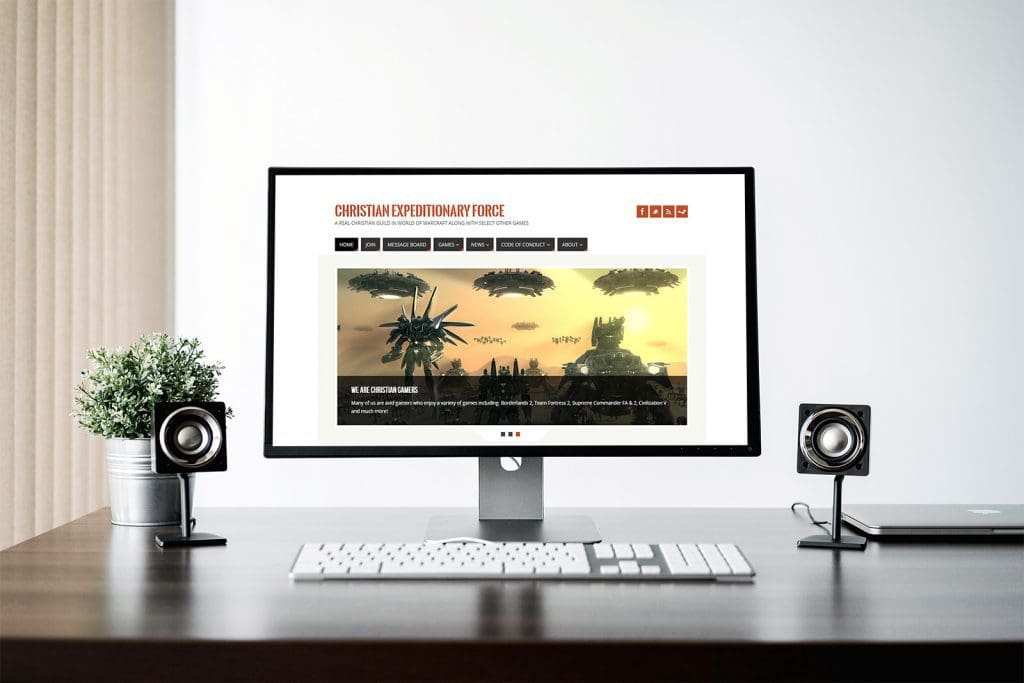
Do-It-Yourself or DIY web design is all the rage. A plethora of companies have released software and services for you to design your own business website. I’ve designed websites for the last two decades. I’ve designed websites for nonprofits, small businesses, and friends. I know a thing or two about DIY web design and will share with you some of the pro’s and con’s of doing it yourself versus hiring a professional web designer.
Why Discuss DIY Web Design?
Paying a professional web designer isn’t always the best choice. There are also situations where doing it yourself is an outright bad idea. We’ll discuss the three major methods of DIY web design for businesses, their individual advantages, pitfalls, and important details to consider. My goal is to provide you with my experience so you can decide what’s best for you and your business — right now.
If hiring a professional web designer is right for you, I’m confident the character and quality of Pure Light Studios’ web design will win you over. What matters is we helped you make an important decision. And, hey, keep in mind, Pure Light Studios also offers graphic design and content writing services. So, keep us in mind if you decide to go the DIY web design route, we can still help you in other ways!
DIY Web Design Comes in Many Forms
Do-It-Yourself web design can be broken down into three basic types or methods. While there are an ever increasing number of options for creating websites, we’re focusing on options relevant to home and small business as well as nonprofits operating on a budget.
Below is a list of the three main methods of DIY web design. The list has been linked to their relevant sections in case you’d like to jump to a particular section.
In the following sections, we’ll discuss each DIY web design method in more detail, along with a nifty infographic summarizing key points. If you’d like to skip all of the DIY options, and just read about professional web designers, you can click here.
DIY Web Design: Manual
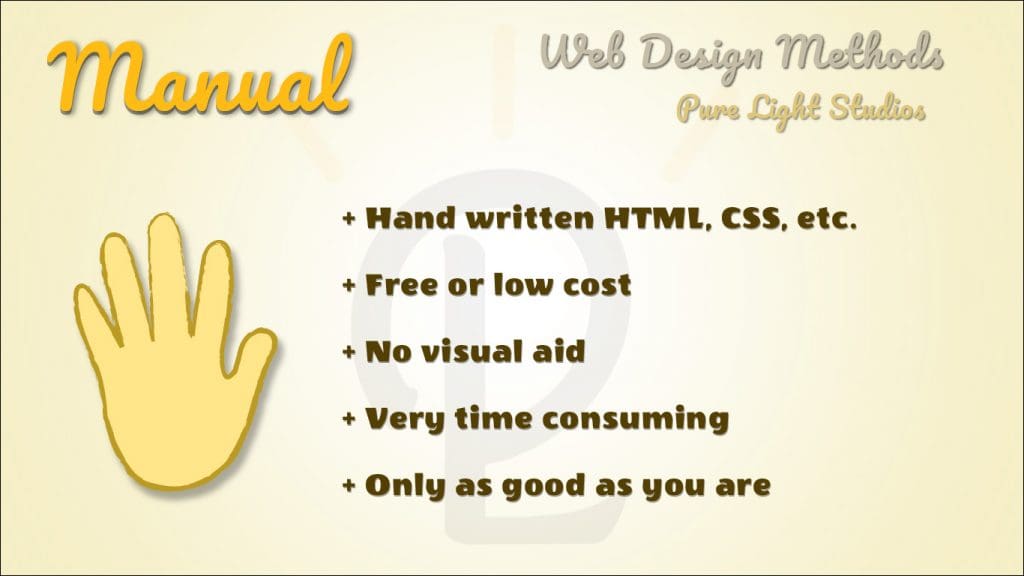
Run Down
This is how our ancestors built websites — their bare hands, Notepad, and a thick HTML manual. This is the most primitive method; often favored by web design professionals for its raw control and simplicity. While it’s great way to learn HTML or CSS (the core markup languages used for designing websites), it’s not particularly the fastest way for a beginner to get their new website online.
You’re going to spend dozens of hours learning HTML, CSS, and possibly JavaScript. Then, many more hours learning how to make that code look like something a customer finds aesthetically pleasing, intuitive to use, and functional — the design part. Design sense often takes natural talent and years of experience. It’s not something you can just study and instantly get.
If this hasn’t deterred you (good for you!), don’t buy a book to learn how to code. Coding standards on the web change frequently. Any book will almost certainly be outdated before you get it home. There are a bunch of online resources. Here are a few of my personal favorites:
- Code Academy – Free online lessons for a variety of coding languages
- W3C Schools – Amazing online resource which includes list of code standards, lessons, examples, and more.
- CSS-Tricks – CSS Tips, Tricks, and Tutorials
Bottom Line
The biggest issue with web designing by hand is learning. While learning the basics of HTML and CSS isn’t difficult, mastering the ability to provide a user-friendly website with aesthetic appeal is. Even most professionals don’t work from scratch. As such, this isn’t the best DIY web design method. Any money saved will be lost in countless hours of studying. Time is money after all.
DIY Web Design: Application
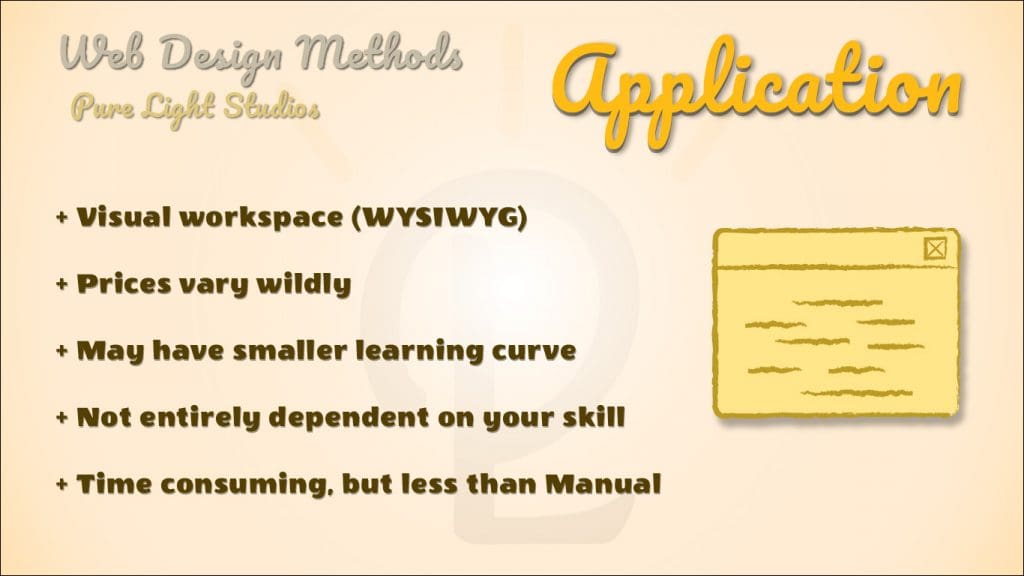
Run Down
DIY web design with an application is a more practical solution over hand coding. Designing with an application lowers the learning curve by writing the code for you. The program simulates how your page may appear in a web browser and you edit it in place. This is called WYSIWY editing, short for What You See is What You Get. That said, this time gained can quickly be lost if the application has a complicated or poorly designed interfaced.
Do your research. Make sure the web design program you choose is user-friendly and offers features you’ll actually use. There is no point buying an expensive piece of software which requires a college degree to operate if all you need is a simple website for your business. More expensive doesn’t always mean better.
Here are just a few of the most popular DIY web design applications:
Counterintuitively, web design applications aren’t always the best code writers. Often, the code produced is optimized for the program to quickly allow you to edit it, and not so much to be clean and quickly read by a browser. This can slow page load times or hurt browser compatibility.
Finally, DIY web design applications may offer some templates, but typically you’re responsible for creating the design. You will still need to learn design practices and how to make an easy to navigate website. As we mentioned in the previous section, this isn’t an easy task.
Bottom Line
Using a DIY web design application can skip over the learning curve of learning HTML and CSS, but it’s not without its own problems. Going the application route can save money, but don’t forget time is money. Time spent learning a new program and how to design a website could be spent doing other more productive things for your business. Still, it’s definitely a viable option.
DIY Web Design: Online Service
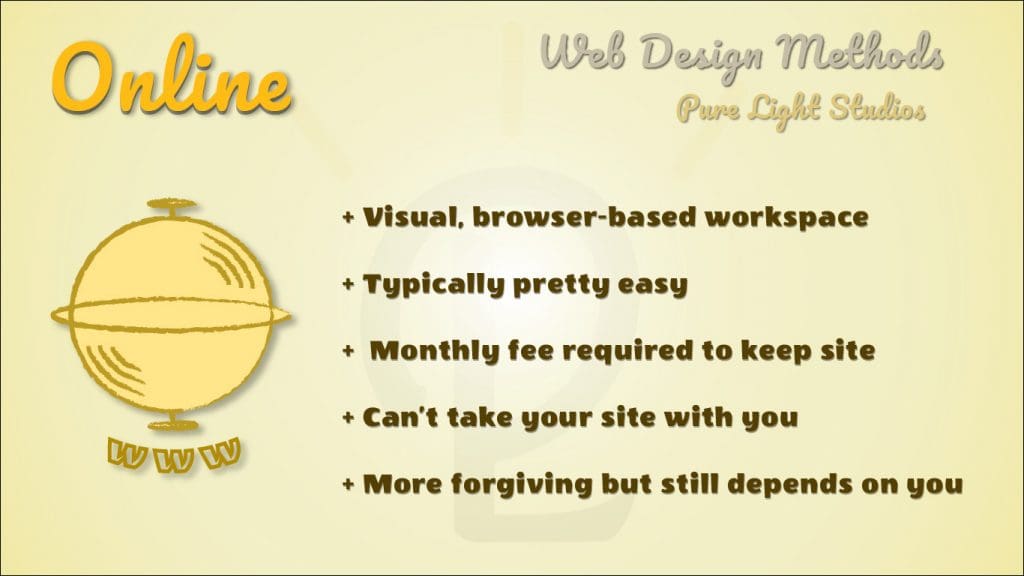
Run Down
DIY web design using an online service isn’t new. I remember using an online website builder in the late 90’s. However, the sophistication and quality of the websites you can create has reached new heights. Now, practically anyone can create a nice looking website.
This has been achieved through simplifying the process of creating a website. Professional looking websites are created by dragging and dropping, pointing and clicking, and filling out web forms. Those selections are then inserted into pre-made templates, typically designed by their team of professional web designers.
The variety of templates available varies from company to company. Some companies have a wide selection. That said, keep in mind there are likely thousands of other businesses using the same template you’re using. If you want your business to standout, you may be disappointed to find you’re all wearing the same dress to the ball. Of course, if you’re on a limited budget and need something quick, it’s better than the manual or application route.
That said, there is an insidious draw back to the online DIY website: You don’t own your website. You’re renting a space and you’re evicted when you don’t pay. Most DIY web design services are on proprietary platforms. This means, if you decide you want to try another provider or transfer to your own host, there is no way for you to bring your website with you.
You don’t own your website
Typically, online DIY web design services offer low monthly costs for basic websites. But, that monthly cost adds up. More advanced options can double or even triple your monthly price. One popular service I researched while writing this article charged $46 a month for an online store — that’s $552 annually. That’s a lot of money for a website you have to setup yourself, can’t take with you, and are limited to a prefabricated template.
Bottom Line
An online service is an okay option if you’re starting out and don’t have a lot of money saved up. You may feel constricted by the limited design templates and inability to take your website with you. If that’s not a big deal, after paying almost as much as hiring a professional, you’re still responsible for setting up and managing your website.
Hiring a Professional
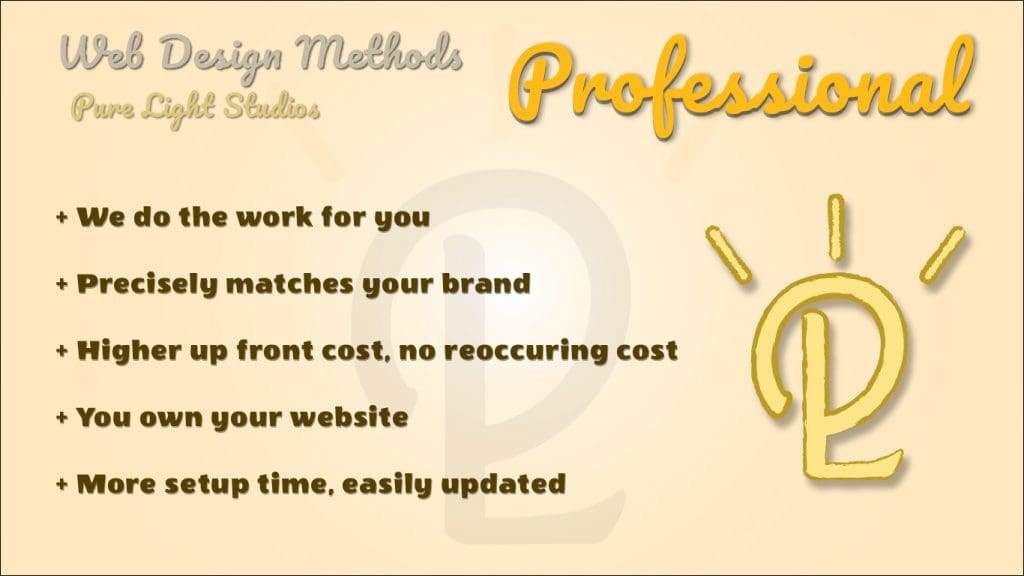
Run Down
If you’re a home business or small business owner, hiring a web designer is almost certainly your best long-term solution — as long as you hire the right one. Designing a website is an arduous task which requires years of experience to get right. Your website reflects your business. Tim Knox of Entrepreneur.com explains,
It’s not enough that you just have a website. You must have a professional-looking site if you want to be taken seriously…Your site may be the first chance you have at making a good impression on a potential buyer. If your site looks like it was designed by a barrel of colorblind monkeys, your chance at making a good first impression will be lost…It’s actually better to have no website at all than to have one that makes your business look bad.
According to statistics, even if you have a brick-and-mortar store, 81 percent of customers will look at your website before buying. It’s your first impression — you need to get it right.
As an entrepreneur, I know how easy it is to get trapped trying to do everything yourself. It saves money. You like having control. It feels right. But, I realized I was spending a lot of time trying to learn things someone had already learned for me. While it may cost money, it saves a lot of time. Time is money. But it’s more than that. Time is life. The time you’re not spending figuring out a website is time you could be spending with friends and family.
Generally, it’ll take longer for a professional web designer to complete your website than a basic DIY website. This shouldn’t come as a surprise. It’s a website custom designed for your brand and your business — not a reused template. As Pure Light Studios deals exclusively with websites designed on WordPress, after the website is designed, maintenance and updates are a breeze.
Upfront costs are higher with a professional web designer. Most designers expect half or all of the total cost upfront. This can be an obstacle if you’re operating on a limited budget. Keep in mind, you’re paying for your most important marketing resource. Compare that to two years of paying for a DIY website subscription and you ultimately save time and money.
Not all web designers are created equal. The price can vary from a couple hundred to tens of thousands of dollars. A company specializing in websites for multinational corporations isn’t the best choice for a home or small business. Find a web designer in your price bracket which focuses on websites geared towards your needs.
Bottom Line
If you own a small business, you should consider hiring a professional web designer. Choose a designer which specializes in small business websites. You’re embarking on a business relationship to create an important part of your business. Make sure you’re looking for a professional web designer that’s personable and willing to introduce you to the process of having a website created for your business.
We’re Here to Help
Have questions? We’d be happy to answer your questions, discuss your project, and find the best options. Let’s talk !
Pure Light Studios specializes in home and small business as well as nonprofit web design, graphic design, and content writing.
Leave a Reply